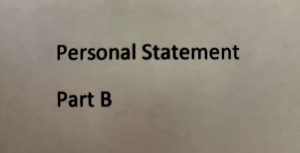
We have been getting some questions about the personal statement guidelines, particularly Part B. Our website says specifically that Part B should use bullet point format only. However, I wrote a blog post on personal statements that stated the following:
“In Part B, you are expected to use bullet point format to list other activities or achievements that you want the Admissions Committee to know about. Breaking these into categories – education, work experience, volunteer experience, extracurricular activities, etc. – can help tell a story with your bullet points. It’s important to always use dates so that we know what part of your story each point comes from. It’s likewise important to tell us how what you are listing relates to law. At the end of each section, write a sentence or two that outlines how these activities or achievements tie in with your Part A narrative.”
To clarify, the two statements (that from the website and that from the blog post) are not inconsistent. Bullet points can be lengthy, they can have indented sub-bullet points, they can have a header, and they can have a sentence or two summary.
What we try really hard to do is not give examples or templates of what this should look like because we believe strongly that doing this takes away from your unique voice and your ability to tell your story in a way that best suits you. Thus, the format is intended to be followed (bullet point format only) but not to be restrictive (you can apply the bullet point format loosely).
For those who must have a template, I have created two examples that are completely unrelated to law or post-secondary education.
Part B Example 1:
Dinner
- Grocery List
- Carrots, Produce Section
- Celery, Produce Section
- Onion, Produce Section
- Potatoes, Produce Section
- Cream, Dairy
- Bread, Bakery
- Materials
- Stock pot
- Knife set
- Wooden spoon
- Ladle
- Bowls and plates
Tonight, I am making soup for dinner. Soup is a time-honoured tradition in our family on cold days. A healthy dinner is important to feed my partner and children.
Part B Example 2:
My Dog Moose
Moose is a 3-year-old chocolate lab that we have had since July. He is a rescue dog who experiences considerable separation anxiety.
- Places that I took Moose this weekend:
- We went for a car ride Saturday afternoon;
- We went for several walks, as this is part of our daily routine.
- We went to the field to see the cattle Sunday morning. The cattle were disinterested.
- We went swimming in the river Sunday afternoon. Moose swam; I did not (see above Example 1 about cold weather).
- Things I did with Moose over the weekend:
- We played fetch. We try to make fetch happen a lot.
- We had a good cuddle every morning.
- He had a nap at my feet while I knitted Saturday afternoon.
- I asked him how his days was every evening. He did not respond but wagged his tail.
I find it’s important to take Moose on adventures and to spend a lot of time with him. While familiarity helps him feel confident, new experiences keep him curious and stimulated. Spending time with Moose is also really important for my mental health.